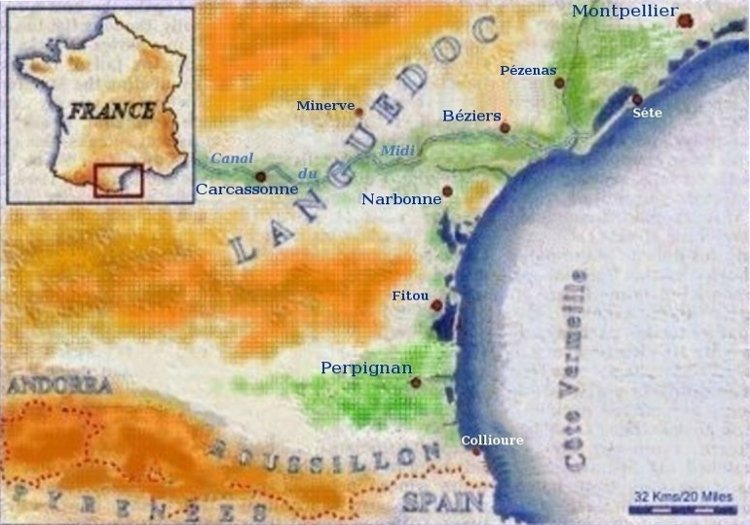The Languedoc by Christopher (Rusty) Tunnard
The Languedoc
If you ask several Frenchmen to define the Languedoc, you will almost certainly receive a variety of answers. That it is a part of the Midi (another part of France that defies exact definition but refers to the southern part of the country) that borders on the Pyrénées and the Mediterranean, will be a common thread, but beyond that, its essential character seems to be a matter of opinion.

Perhaps it is best to start by looking at what the Languedoc is not. It is not a political, geographic, or economic entity although it has had periods of unity under the Romans (as the province of Gallia
Narbonnensis) and the counts of Toulouse in the Middle Ages, it has never been a separate country flying its own flag. Neither is it an ethnically cohesive region, although ethnicity provides the first clue
to constructing a picture of what the Languedoc was and (in the hearts of many Languedocians) is.
The word Languedoc comes from the language once spoken by the people of the south of France. It is a
mixture of Latin and the language spoken by the Gallic and Iberian peoples who had inhabited the area before the Francs and other northern tribes invaded the country between the third and sixth centuries. The name evolved
in the Middle Ages, coming from the way the people in southern France said yes. The literal translation is Language of Yes (Langue d'Oc). The same holds true for the French spoken
by northerners at the time: Langue d'Oil. This difference can still be heard today for oil is the common oui, the generally accepted pronunciation in Paris and the Ile de France, while many southerners still can be heard
acknowledging assent by saying "oc" or "wah" (a loose transliteration).
After the unification of France following the Albigensian Crusade in the thirteenth century, the northern
version became the de facto official language of the country.
The Langue d'Oc developed into a series of provincial dialects in southern France and Catalan Spain. It reached its literary apogee in the poems
of the Troubadours, the poets of the medieval age of chivalry in the courts of Toulouse and Provence, and was revived in the nineteenth century by Mistral, the great Provençal poet, and others. Today several societies and
institutes support the study and use of the L'angue d'Oc.
If the language of the Languedoc is used to define its frontiers, then the Languedoc once extended roughly from the mountains of the Massif
Central in the north to the Rhône, the Pyrenees, and Toulouse in the east, south, and west, respectively. In modern times, especially since the country was arbitrarily divided into départements, or counties, under Napoleon,
and since the turn of the century uprisings of local farmers against the Northern Land Barons and the Paris government, the borders have what is known as the lower Languedoc, the land along the Mediterranean to Spain,
extending inward through the vineyards to the grain farms ot the Toulousain.
The people of this area use their common heritage as a rallying point. Modern visitors must always keep in mind that this is a land
where Albigensian heretics and, later, Protestants were allowed to practice their beliefs without hindrance from the local population. That same population rose up against economic injustices
caused, as they saw it, by northern indifference to their needs. They later formed strong agricultural unions and were among the first to elect Communists to municipal and provincial posts. Today, signs proclaiming
Occitania (Occitan is the adjectival form of it) can be seen throughout the region. These are a symbol not of a true movement but of a desire to have the area recognized as a cultural entity
adequate attention by Paris, especially when it comes to national economic development schemes and price and trade support for wine, by far the most important regional product.
On the positive side, the warm
weather, the slow pace of life, and the hospitality by the Languedocians make a foreign visitor feel relaxed and welcome. The Midi Canal, the sandy beaches, and the ski slopes of the
Pyrénées are but a few of the attractions here, and it doesn't take long to become accustomed to this, pleasant life-style. Long passed by in favour of Provence and the Riviera to the east, the Languedoc is now receiving
more attention from tourism development authorities. This industry in addition to the new high-technology centres springing up around Toulouse and Montpellier, may well hold the key to the economic future of the region.
From - The Canal du Midi and the Languedoc - a Sightseeing Guide - moc.lanacidim@ytsur
